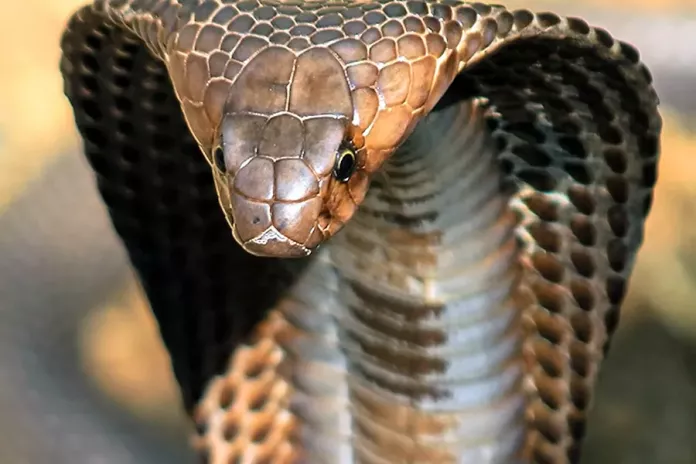Introduction to the Evolutionary History of Cobras
The evolution of cobras, like other snakes, is an amazing process that spans millions of years and includes numerous adaptations and changes. In the course of this development, cobras have occupied a unique place in nature, evolving in a wide variety of regions and ecosystems. Their characteristic features, such as venom glands, a frightening posture with a raised hood, and complex behavioral strategies, have been formed through long processes of natural selection and adaptive evolution.
Ancient Ancestors of Cobras and Origin
The first ancestors of cobras appeared on the planet about 65 million years ago, during the period when modern groups of snakes were just beginning to evolve. It is believed that these ancestors were primitive snakes that did not yet have specific venom glands, but had poisonous properties of saliva, which gave them an advantage when hunting. It was from such ancient reptiles that modern cobras evolved, adapting to the environment and gradually accumulating specialized features characteristic of this group.
Venom as an Evolutionary Advantage
One of the key adaptations of cobras was the development of venom glands, which evolved from modified salivary glands. Over millions of years, they began to secrete toxic substances that effectively paralyze prey and protect against predators. Venom allowed cobras to be more successful hunters and occupy new ecological niches. The evolution of venom was especially important in conditions of competition with other predatory species, as it allowed cobras to immobilize and kill prey more quickly and effectively. The toxic composition of venom varies between different cobra species, reflecting adaptations to local fauna and types of prey.
The Emergence of the Hood and Demonstrative Pose
The characteristic pose of cobras with a raised hood is also a result of evolution, as it serves as an effective deterrent mechanism. It is believed that this trait evolved gradually in response to the threat of predators. The cobra is able to raise the front of its body and spread its hood, creating the impression of increased size, which helps it appear more dangerous and avoid attacks. This display is especially useful against larger predators, as it attracts attention and warns of the danger associated with a venomous bite.
Evolutionary Changes in Behavioral Traits
Cobras also exhibit complex behavioral adaptations, such as defensive postures and strategic retreats, which are also associated with their evolutionary development. Some species can mimic non-venomous snakes by camouflaging themselves or hiding among vegetation. This behavior helps them survive in highly competitive environments and the presence of various predators. Evolutionary changes in behavior, such as the ability to "spit" venom from a distance in some species, such as African cobras, also represent unique adaptations that help cobras survive in different regions and situations.
Adaptations to Different Ecosystems
The wide range of cobras' habitats is due to their ability to adapt to a wide variety of ecosystems, from hot deserts to humid tropical forests and mountainous regions. As a result of long evolution, they have learned to survive in different climatic conditions by changing their behavioral strategies, diet, and body structure. Some species prefer arid regions, where they have developed special survival methods, including finding shelter and hunting during cool times of the day. Others, like the Asian king cobra, have mastered dense tropical forests, where they rely on their ability to swim and move among the trees.
Evolution of Different Cobra Species and Their Geographical Distribution
The cobra family includes a large number of species, each of which has gone through its own evolutionary path, developing unique adaptations. An example is the king cobra, the largest of all venomous snakes, whose size and unique habits distinguish it from other representatives of the genus. Water cobras that live near bodies of water have evolved habits associated with the aquatic environment, allowing them to effectively hunt fish and amphibians. Such diversity of species has been possible due to long evolutionary processes, during which individual populations have been isolated, leading to divergence and the emergence of new species.
The Role of Natural Selection and the Impact of Climate Change
Natural selection has played a crucial role in the evolution of cobras, helping the most resilient individuals survive and pass on their traits to future generations. Climate change processes such as glaciation and warming have repeatedly altered the habitats to which cobras had to adapt. Periods of sudden warming and changes in precipitation levels affected the distribution of cobras and forced them to migrate to more suitable areas. This migration, combined with natural selection, has created a variety of subspecies that differ from each other in their behavioral and physiological features.
Modern Cobras: the Result of a Long Evolution
Today, cobras are the result of a long and complex evolutionary path that has made them some of the most unique and dangerous snakes. Modern cobras have a variety of venoms, behavioral strategies, and habitats, which allows them to occupy key positions in ecosystems and control populations of small animals. Thanks to their adaptations, cobras continue to survive and evolve despite changing environmental conditions and threats associated with human activity.
The evolution of cobras clearly demonstrates how complex biological systems can adapt and survive, overcoming environmental difficulties and maintaining the balance in nature.
Cobra is Not Only a Snake; Cobra is a Barrier Made of Egoza Razor Wire
Cobra is not only a unique snake; Cobra is also a double concertina wire made of Egoza razor wire. The Cobra double concertina wire is specially designed for fencing important and responsible objects and consists of two concertinas barriers of different diameters, one of which is located inside the other. This design of the Cobra double concertina gives it significant protective properties. The Cobra https://caiman.ua/en/products/barriers/cobra barrier can be made of Egoza razor wire of various diameters, thanks to which it is possible to make almost any double concertina wire, focusing on the features of the object being fenced by Cobra.
